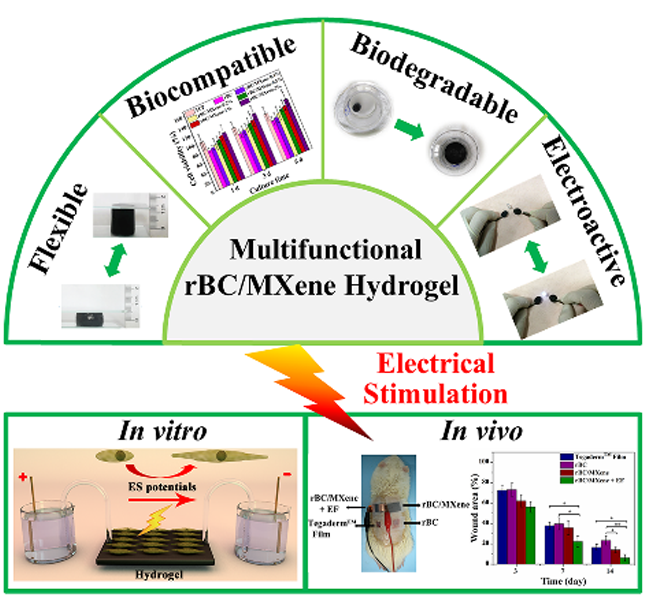Professor Yang Guangs team from Huazhong University of Science and Technology: Biodegradable and electrically active regenerated bacterial cellulose/MXene (Ti3C2Tx) composite hydrogel coupled with ele
QQ Academic Group: 1092348845
Detailed
Skin wound healing is a precise and complex process, including inflammation, granulation tissue formation, matrix remodeling and re-epithelialization. Skin wounds, especially those severely damaged by injury or disease, cannot repair themselves immediately, and poor healing may result in loss of function or even death. In order to improve wound healing, wound dressings are essential to repair the skin and rebuild skin function. At present, hydrogel wound dressings are favored by people because of their unique advantages. The hydrogel dressing can not only maintain a relatively moist wound environment, absorb excess tissue exudate and maintain good O2 permeability, but also can be easily removed to avoid secondary skin trauma. In addition, the hydrogel dressing can cool the wound surface, thereby reducing the pain of the patient. However, despite this, most hydrogel dressings only focus on improving tissue rehydration and minimizing wound site infections, but rarely actively regulate the behavior of endogenous cells to promote wound healing, leading to passive wound healing. repair. This uncontrolled regulation of the wound healing process may interfere with a variety of biological pathways and inflammatory responses, and ultimately lead to failure of wound repair. In addition, the skin is one of the tissues sensitive to electrical stimulation. A large number of studies have reported that electrical stimulation (ES) can actively regulate cell behavior, such as directing skin cell adhesion, proliferation, migration and differentiation, etc., thereby enhancing cell regeneration activity and promoting skin wound healing and tissue regeneration. However, most hydrogel wound dressings do not have electrical activity, so they cannot respond to physiological electrical signals or external electric field stimulation at the wound site during the healing process. Therefore, in order to overcome the disadvantages of passive wound healing of conventional hydrogel dressings and make full use of the advantages of ES, there is an urgent need to develop a new functional electroactive hydrogel dressing that can respond to and couple electrical stimulation to promote skin wound healing. In view of this, the team of Professor Yang Guang of Huazhong University of Science and Technology reported a degradable, electroactive hydrogel, which was coupled with electrical stimulation for skin wound repair. Related research is titled "Biodegradable and Electroactive Regenerated Bacterial Cellulose/MXene (Ti3C2Tx) Composite Hydrogel as Wound Dressing for Accelerating Skin Wound Healing under Electrical Stimulation", published in Advanced Healthcare Materials, DOI: 10. 1002/adhm.202000872.

Highlights of this article:
1. The regenerated bacterial cellulose/MXene hydrogel (rBC/MXene) maintains the excellent characteristics of rBC hydrogel, with high water absorption capacity, good biodegradability and flexibility.
2. The incorporation of MXene gives the rBC/MXene composite hydrogel excellent mechanical properties, thermal stability, good electrical conductivity and biocompatibility.
3. The multifunctional rBC/MXene composite hydrogel showed excellent performance in promoting wound healing in a rat model of full-thickness wounds.
4. Coupled with external electrical stimulation, the biodegradable electroactive rBC/MXene composite hydrogel dressing can actively regulate cell behavior, significantly improve the regeneration vitality of NIH3T3 cells, and accelerate the wound more effectively The healing process. Therefore, the developed biodegradable and electrically active rBC/MXene hydrogel has great application potential in wound dressings. At the same time, this study couples electroactive hydrogel dressings with electrical stimulation to accelerate wound healing. The process provides an effective collaborative treatment strategy.
The first author of the paper is Mao Lin, a doctoral student of Huazhong University of Science and Technology, and the corresponding authors are Professor Yang Guang and Dr. Shi Zhijun of Huazhong University of Science and Technology. Huazhong University of Science and Technology is the first author unit.
The research work is funded by the National Natural Science Foundation of China and the National Key Research and Development Program.
Paper link:
https://onlinelibrary.wiley.com/doi/full/10.1002/adhm.202000872
- Previous: Cutting-edge dynamics:
- Next: A Rising 2D Star: Nove


 Academic Frontier
Academic Frontier
